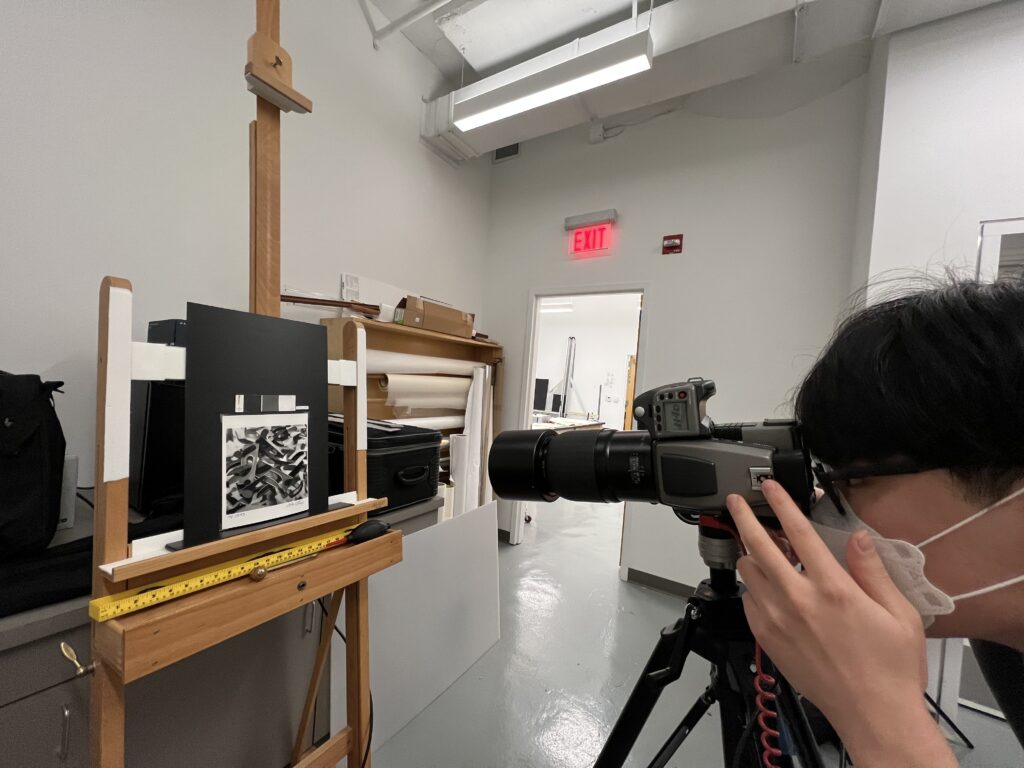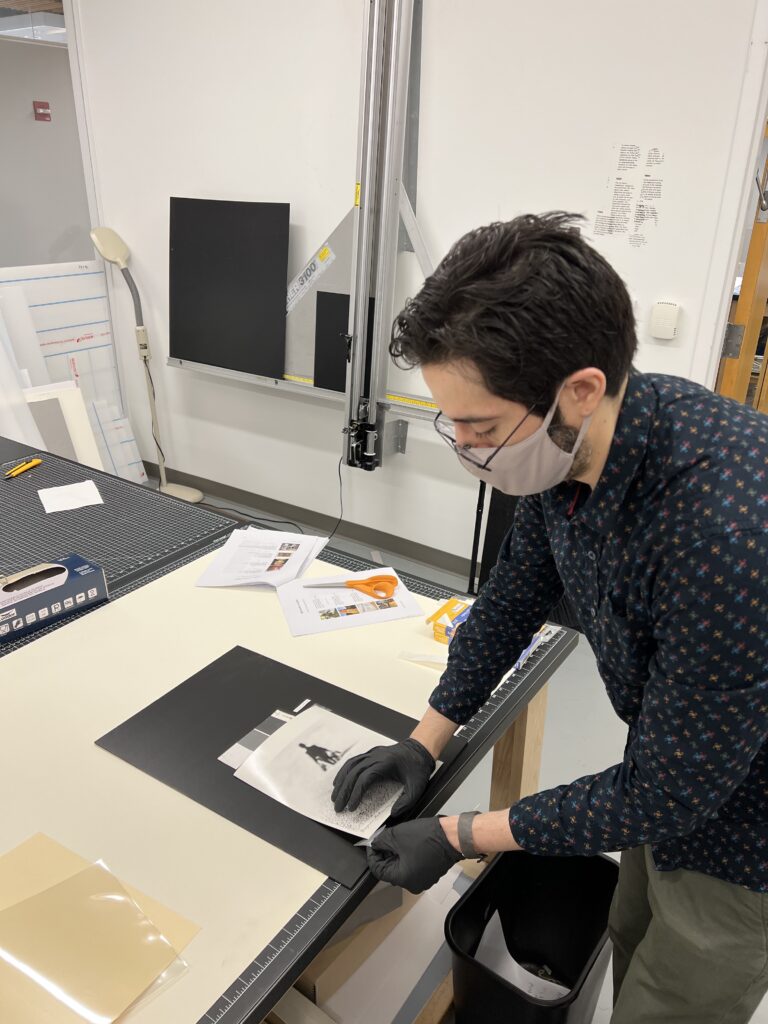PAFA is excited to welcome Sharon Yoon as our new Museum Collections Assistant. Sharon recently completed her bachelor’s degree at Drexel University studying Art History. She will help support many activities that help promote the care and use of the collection as help conduct research.
staff
Digital Treasure Trove: Project Update
Contributed by Hoang Tran, Director of Archives & Collections and Zoe Smith, IMLS Project Museum Collections Assistant
It’s been a busy summer at PAFA. At the end of June, we had to say good-bye to our IMLS Collections Assistant L. L had an amazing job opportunity to work for a local artist as a studio assistant. We wish L all the best and thank them for all their hard work and dedication! L’s work helped us hit major milestones on the project–completing 99% of works on paper photography, completing all subject terms in the catalog records, and pushing us over 60% completion of the project!
We were fortunate to rehire the position quickly. Our new IMLS Collections Assistant is Zoe Smith who started August 21, 2023. Please read Zoe’s introduction blog below:
My name is Zoe Smith, I am a recent graduate of Drexel University where I completed a bachelor of science in photography. I have a love of nature and art that merges into the work that I make. I am passionate for printing my photographs, and experimenting with alternative printing methods. I am extremely excited to use my photographic experience to contribute to the art world by updating PAFA’s amazing collection of art. This task feels exceptionally important to me, and I hope people are able to learn and grow from this fantastic resource.
My work at PAFA consists of assisting in photographing and digitizing the extensive collection of paintings, sculptures, and other works of art. Being able to look into the history of each one of these objects is an immense privilege that I am very much looking forward to.
My first week here I dove right in and began photographing various medallions. The intricate carvings on each of these surfaces have been a fun challenge to photograph. Using a lightbox to evenly light the subject, we have been using multiple exposures to get different parts of the medallion perfectly in focus. This is necessary because of the various depths of the carving on these objects.
After photographing I have been bringing the 2 to 6 exposures into a focus stacking software and combining them into one photo. This technique can be challenging and it has been great training my eye to see the slight differences in focus. I am looking forward to using the same technique on small busts and sculptures. Each artwork poses an exciting new challenge in photographing that has been very rewarding. I love to imagine the thousands of people before me that have had a connection to this art, which deepens my own personal connection to it.
About the Institute of Museum and Library Services
The Institute of Museum and Library Services is the primary source of federal support for the nation’s libraries and museums. We advance, support, and empower America’s museums, libraries, and related organizations through grantmaking, research, and policy development. Our vision is a nation where museums and libraries work together to transform the lives of individuals and communities. To learn more, visit https://www.imls.gov/and follow us on Facebook and Twitter.
Setting up for the 122nd Annual Student Exhibition
Opening this month is PAFA’s Annual Student Exhibition (ASE), now celebrating its 122nd year. Our archives have a long practice and record of documenting the ASE, and its connection to student life here at the school and museum, like in the image here from 1910.
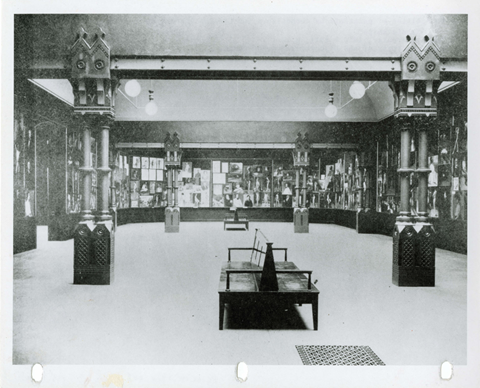
Below are some images of the installation process from this year’s exhibition, which span all three floors of the Samuel M.V. Hamilton Building.


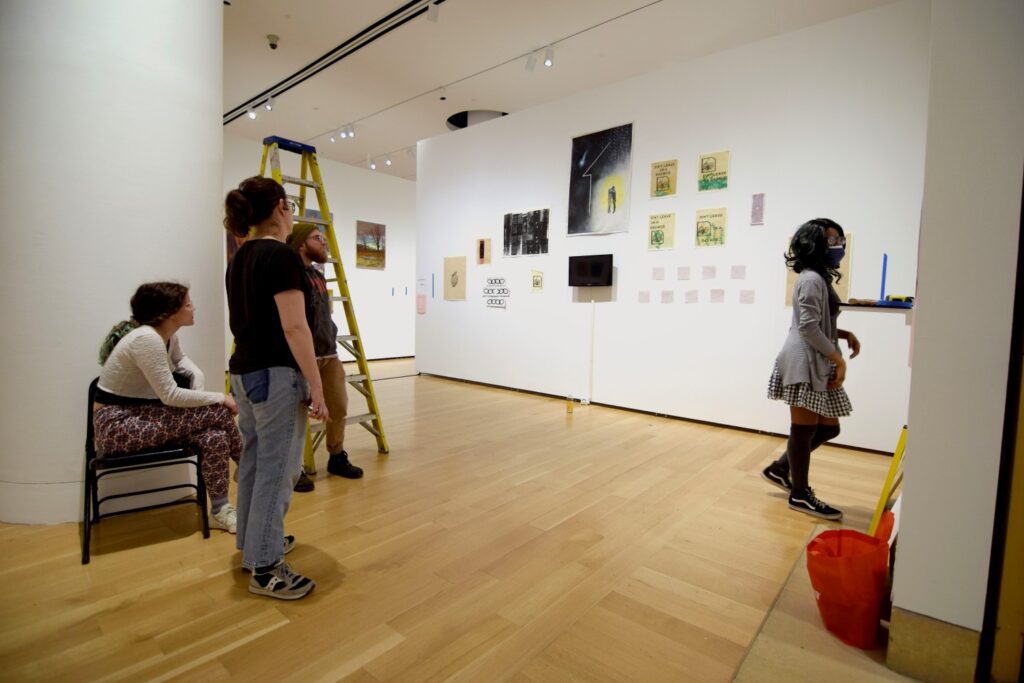
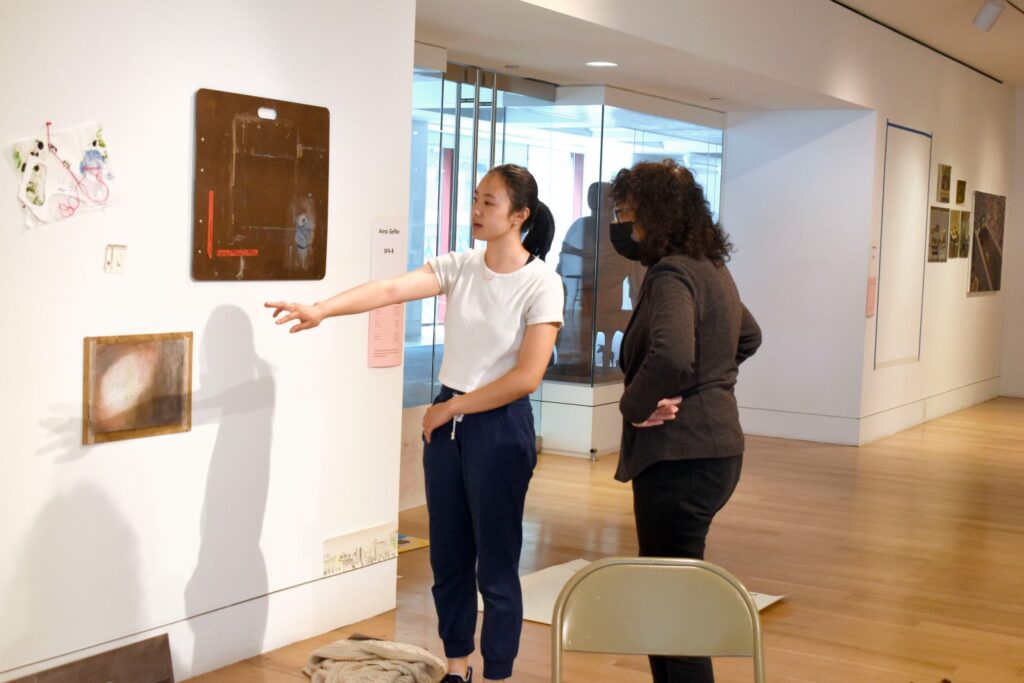
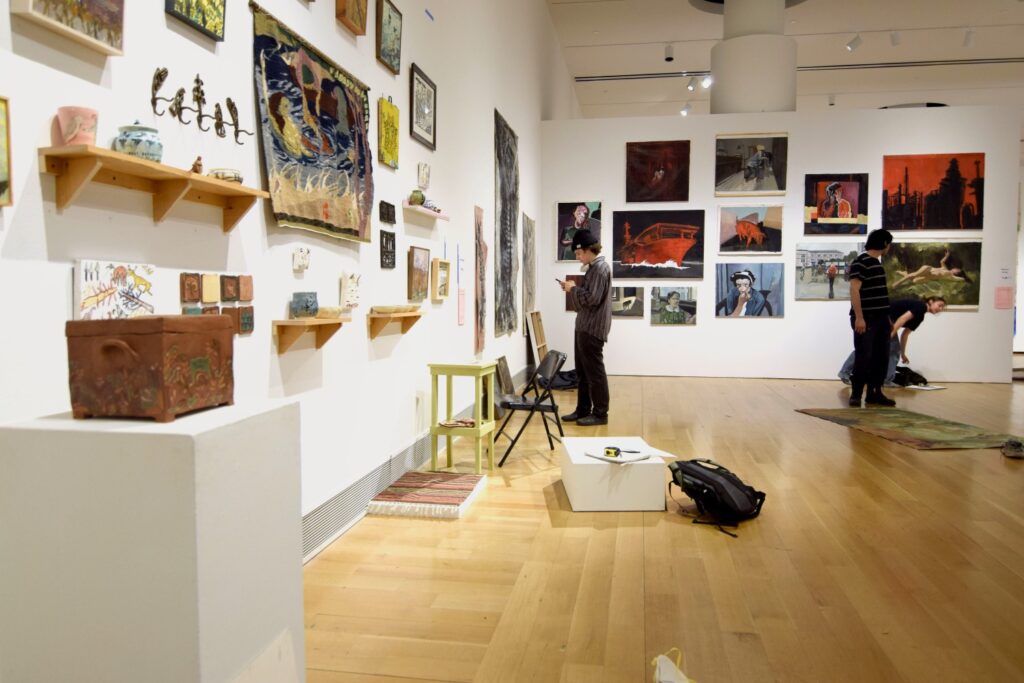
Learn more about this year’s Annual Student Exhibition and its corresponding events here: https://www.pafa.org/school/annual-student-exhibition
Learn more about the history of the Annual Student Exhibition here: https://pafaarchives.org/page/ase
About the Institute of Museum and Library Services
The Institute of Museum and Library Services is the primary source of federal support for the nation’s libraries and museums. We advance, support, and empower America’s museums, libraries, and related organizations through grantmaking, research, and policy development. Our vision is a nation where museums and libraries work together to transform the lives of individuals and communities. To learn more, visit https://www.imls.gov/and follow us on Facebook and Twitter.
122nd Annual Student Exhibition
It’s that time of year again! Students, faculty, and staff from the school and museum are actively working to complete the installation of the Annual Student Exhibition (ASE). ASE is considered a capstone event for BFA and MFA students that coincides with graduation.
ASE “Walls” vary from student to student, each pursuing an individual interest. The emphasis of the exhibition is on creating a cohesive body of related works through sustained studio practice and critical inquiry.
While the ASE is spearheaded by the school, the Museum also plays an active role in guiding and providing assistance to students. PAFA’s art preparators help students prepare their works to be hung, help with installation, and provide feedback on aesthetics.
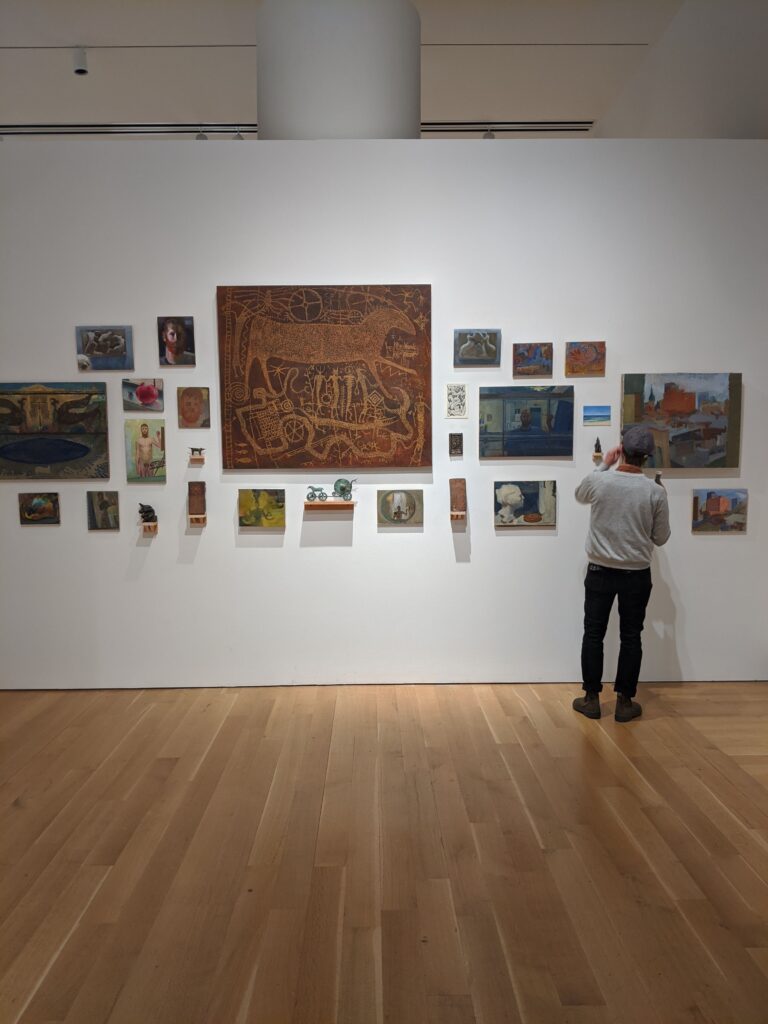
Contract art preparator Travis Grant

PAFA Assistant Art Preparator Jacob Stevens
Digital Treasure Trove: Introducing the New Museum Collections Assistant
Contributed by PAFA Museum Collections
The Museum Collections Team is pleased to introduce L Autumn Gnadinger (they/them/theirs), who will be stepping into the role of the Museums Collections Assistant through the remainder of the IMLS grant project. L is an artist, writer, and educator with a background in museum work. They earned their MFA from Tyler School of Art and Architecture and have previously studied at Indiana University Southeast in New Albany, IN and Transylvania University in Lexington, KY. L is a former Core Fellow of Penland School of Craft in Bakersville, NC, and an editor and co-founder of the journal Ruckus, which engages art in the American Midsouth and Midwest.
With a range of experience in photography, design, and file management stemming from their work with Ruckus, L will be helping PAFA with its core goals of photographing works of art in the permanent collection, updating the file management connected to the permanent collection, and finally testing out the new content management system for the new—forthcoming—online collection.
About the Institute of Museum and Library Services
The Institute of Museum and Library Services is the primary source of federal support for the nation’s libraries and museums. We advance, support, and empower America’s museums, libraries, and related organizations through grantmaking, research, and policy development. Our vision is a nation where museums and libraries work together to transform the lives of individuals and communities. To learn more, visit https://www.imls.gov/and follow us on Facebook and Twitter.
Digital Treasure Trove: Project Update
Contributed by Hoang Tran, Director of Archives & Collections
How time flies! It has been a year since we were awarded the IMLS grant. It seems fitting that I take this chance to provide an overview of all the changes and activities that have been completed so far.
The first major update is in regards to staffing changes. HoJun who served as the Project Museum Collections Assistant decided to leave the project early. In his place, we were fortunate to hire an amazing candidate, L Gnadinger. L is an artist, writer, and educator originally from Louisville, KT who has experience with art handling, writing, and arts administration. We’re happy to have L join the IMLS project team!
We’ve completed the first round of cataloging for all permanent works in PAFA’s collection. The main emphasis for this round of cataloging was to obtain accurate biographical information—life dates, place of birth, nationality, gender, race, etc. This round also included ensuring all objects had at least one subject access point, standardized date, copyright information, and of course, no spelling errors.
Photographing the collection has been challenging due to the staff change, technology problems, and institutional commitments. However, we managed to bounce back rather quickly when we switched to photographing 3D works (sculpture) in the second half of the summer. To date, we have photographed 82 small/medium sized sculptures (21%). In the past, we took 1-3 photos of a sculpture in a frontal view only. This time, we decided to photograph the sculpture 10 times to create a full 360 degree view of the work. We believe this added work would not only help PAFA document the work better, but also help curators and researchers view other markings such as a signature or date that is typically on the back of a sculpture.
PAFA’s legacy files are stored in a complex web of folders with tiff and jpg files intermixed with unconventional file naming standards. L has taken on the immense task of digital file management. Fortunately, L has Python programming skills that proved to be invaluable for this task. After a few weeks of brainstorming, testing, and team meetings, L was able to get a grasp of what the best approach would be.
I’ve been working closely with PAFA’s Registrar, Danielle McAdams, who is assisting with the CMS implementation phase of the project. The data migration and implementation of a new CMS is largely done by the vendors. We are currently reviewing the vendor’s feedback for crosswalks that aren’t compatible with the new CMS and determining if we require anything more customized for our needs. So far, there hasn’t been any major issues.
Digital Treasure Trove: Photographing works of art
Contributed by HoJun Yu, Project Museum Collections Assistant
My first glimpse of museum collection photography began when I was employed at the Metropolitan Museum of Art. At the Met, I worked on a similar grant funded project that gave me the opportunity to see how works of art were photographed by collection staff. I was thrilled about the possibility of doing such work myself when I was hired by PAFA.
As PAFA’s collection photographer, Adrian Cubillas has provided me guidance, supervision, and support in learning the intricate processes for photographing works of art. The first phase of the project would focus on photographing works on paper. During the first few photographing sessions we photographed unframed and unmatted prints.
It was great working with another photographer who brought his perspective and experience in collection photograph. He walked me through all the basics of photographing an artwork and once I learned the essentials, we were able to speed through the work as he and I are both photographers. Even though I have been a photographer for quite some time now, I have been learning about new techniques as most of my photographic work involves people, rather than objects.
Using studio lights to photograph works of art can take much meticulousness, as we need to accurately capture the brightness and colors. The most challenging part has been troubleshooting the glares we come across every now and then, especially with prints that have more reflective surfaces. Once again, as Adrian and I are both photographers, combining our knowledge and efforts has been helping significantly. To troubleshoot such problems regarding the glare, we adjusted the angles of the strobe lights. Rather than lighting up the artwork directly, we decided to turn the strobes around to bounce them off the walls. By doing so, we were able to reduce the glares that kept appearing especially on photographic prints.
Another obstacle that we encountered was the condition of some of the prints themselves. While most of the prints we have been photographing have been relatively flat, the rest have seemed to retain a slight curl from being previously rolled up. The curl posed a minor problem as certain parts of the print will not be not be completely sharp. To solve this, we simply went with a slightly deeper, wider depth of field to make sure all parts of the print were in focus. While convenient, changing the depth of field requires subtlety and care. If the depth of field is too deep, the ISO will have to be increased, which will consequently produce a photograph with more noise. The changes in the depth of field need to be conservative and as small as possible.
For the first month of photographing, we managed to photograph 85 works on paper.
About the Institute of Museum and Library Services
The Institute of Museum and Library Services is the primary source of federal support for the nation’s libraries and museums. We advance, support, and empower America’s museums, libraries, and related organizations through grantmaking, research, and policy development. Our vision is a nation where museums and libraries work together to transform the lives of individuals and communities. To learn more, visit https://www.imls.gov/and follow us on Facebook and Twitter.
Digital Treasure Trove: Data Cleanup
Contributed by HoJun Yu, Project Museum Collections Assistant
An interesting part of my work at PAFA is my ability to apply my scientific research background to support the grant project. Under Hoang’s (Project Director and PAFA’s Director of Archives) supervision and guidance, I have been cleaning up the museum’s collection data. The museum currently uses Mimsy XG, but the project will also see the migration and implementation of a brand new content management system (CSM). The work i’m doing will directly support the data migration to Axiell Collections. Despite the modest nature of data cleanup, the work is crucial for the museum’s operations and overall deeper understanding of its collection.
Through this process, I have been learning how to use Mimsy, which I had not used before. During my time at the Metropolitan Museum of Art, I mainly used FileMaker Pro to maintain and edit data for Oddy test results within the Department of Scientific Research. My experience with Mimsy so far has shown me that it is more customizable and flexible than FileMaker Pro.
The reason the data portion of my work is so crucial is that collections staff rely heavily on the information that is stored in Mimsy. Whether curating exhibitions or analyzing collecting trends, collections staff need to have the ability to access various bits of information on the art and the artist. In recent weeks, I have been researching and updating different aspects of the artists’ lives, such as their gender, life dates, and nationality. This type of information should be easily accessed because then for example, when a curator needs to prepare for an exhibition of art by female artists, they can just filter the search in the database by gender. Besides adding new information, I have also been cleaning up existing data. Because Mimsy can be sensitive down to every letter or space in the search bar, I need to make sure all the formatting is consistent and uses standard vocabulary.
One of the biggest challenges in this work has been researching artists who are or were not necessarily well known enough to have easily accessible information online. Sometimes, even well-established institutions had inconsistent information regarding these artists on their websites. For such situations, less conventional methods were employed, such as digging through birth records, obituaries, and even blogs written by hobbyists who have already done the meticulous research on these artists. Whenever I was able to succeed with these methods, I would save the documentation so we have it on file for future use. The purpose of this process is not only to obtain accurate information for the sake of data, but also to make the information as accessible as possible for anyone who wants to learn.
About the Institute of Museum and Library Services
The Institute of Museum and Library Services is the primary source of federal support for the nation’s libraries and museums. We advance, support, and empower America’s museums, libraries, and related organizations through grantmaking, research, and policy development. Our vision is a nation where museums and libraries work together to transform the lives of individuals and communities. To learn more, visit https://www.imls.gov/and follow us on Facebook and Twitter.
Digital Treasure Trove: Project Update
Contributed by Hoang Tran, Director of Archives
We are excited to announce the official launch of the IMLS grant funded project to photograph all works in PAFA’s permanent collection up to 2018. In addition, there will be a large scale data cleanup of the collection catalog records.
PAFA is happy to introduce HoJun Yu who will serve as the Project Museum Collections Assistant. HoJun is not your traditional museum professional. His educational background was actually in chemistry which may seem odd but there are definitely overlapping skills, particularly when it comes to critical thinking and analytical skills. For instance, these skills will be invaluable for his work reviewing, updating, and creating better catalog records for PAFA’s entire permanent art collection data.
The other portion of his duties is supporting PAFA’s efforts to photograph its permanent collection. HoJun has a passion for photography which is demonstrated by his work as a photographer during his undergraduate studies as well as freelance work (https://www.hojunyu.com/).
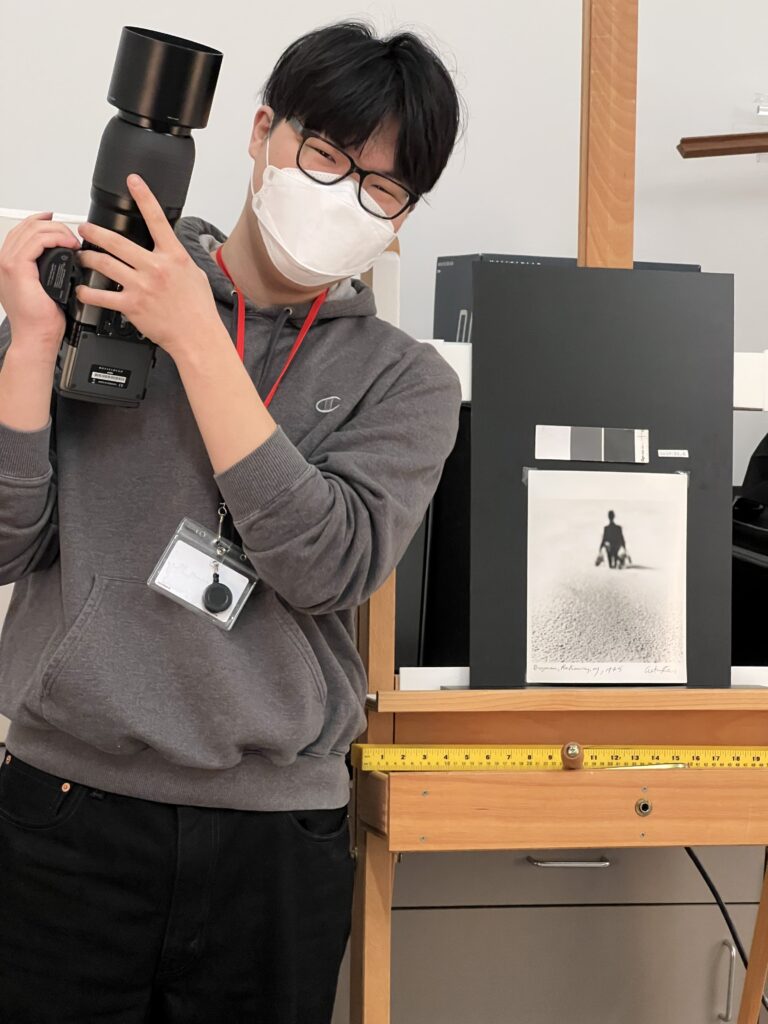
Please check back here regularly for updates on the project.
About the Institute of Museum and Library Services
The Institute of Museum and Library Services is the primary source of federal support for the nation’s libraries and museums. We advance, support, and empower America’s museums, libraries, and related organizations through grantmaking, research, and policy development. Our vision is a nation where museums and libraries work together to transform the lives of individuals and communities. To learn more, visit https://www.imls.gov/and follow us on Facebook and Twitter.
Goodbye from the John Rhoden papers team!
Contributed by the John Rhoden papers team, Kelin Baldridge and Jahna Auerbach

This week, our journey with the John Rhoden collection comes to an end. A year of full immersion in the life of John and Richenda Rhoden has resulted in a project that will soon be open to the public, for researchers, the curious, and everyone in between.
Anyone who works closely with a human subject – archivists, curators, historians, authors, researchers – can relate to the level of attachment that we, the John Rhoden papers team, feel towards John and Richenda Rhoden.
As sad as we are that our journey with the Rhodens has come to an end, we are immensely grateful to have had the opportunity to work so closely with their remaining legacy. Working with their archives, we get a glimpse of how charming and interesting people they truly were. They both lived fascinating lives together.
The physical remnants of one’s life can be incredibly powerful. Though it will never be the case, we feel we knew them personally after connecting with the records they left behind. From the collection, we have been fortunate enough to learn that John Rhoden was a sharp businessman, resilient, joyful, and aware of how he could use his skills to help others. He created a path and a career for himself in an America that did not lend itself to his success.

The documents and the photographic materials come together in this collection to create a full picture of who John Rhoden was. The papers are deeply rooted in his professional life, but photographs of him smiling and of the way he interacted with those around him hint at the kind of man he was. Like many of us, John loved to document his travels by taking photographs. Browsing through the images, one not only gets transported back in time, but also gets to view the world through John’s lens and perspective–underexposed and all.
The records revealed how kind, joyful, and charismatic both John and Richenda were. They seemed to be the type of people who commanded the attention in a room, and whose presence lifted the mood. What seems to have struck people about the couple was their warmth, openness, and generosity. Both were successful artists and professionals, but what seems to have stuck with people most was their character.
Another notable aspect of this collection is its expanse. Not only does it tell the stories of John and Richenda, it offers a full-color glimpse into the world in the 1950s, it tells the stories of many artists, lost and forgotten to time, it creates connections and networks among people, places, and things that might otherwise have nothing in common. In addition to telling the story of its primary subject, it contains seemingly infinite threads and tangents waiting to be fully explored.

As we now open the collection to public use, we wanted to thank the NEH and the incredible support system at PAFA that not only made our work possible, but downright enjoyable, through a global pandemic no less. Furthermore, we want to thank Hoang Tran and Dr. Brittany Webb for being the most incredible collaborators and leaders that two young professionals could ask for.
Though our official work with the Rhodens is ending, we are looking forward to using Hoang’s Rhoden portal and visiting Brittany’s John Rhoden exhibition many times when it opens!

A note from Assistant Archivist, Jahna Auerbach:
The portion of the John Rhoden papers that has had the biggest impact on me is contained in just one box, Richenda Rhoden’s personal papers. From the beginning, I had a personal connection to Richenda because of all of the incredibly endearing photographs of her posing with her various cats.
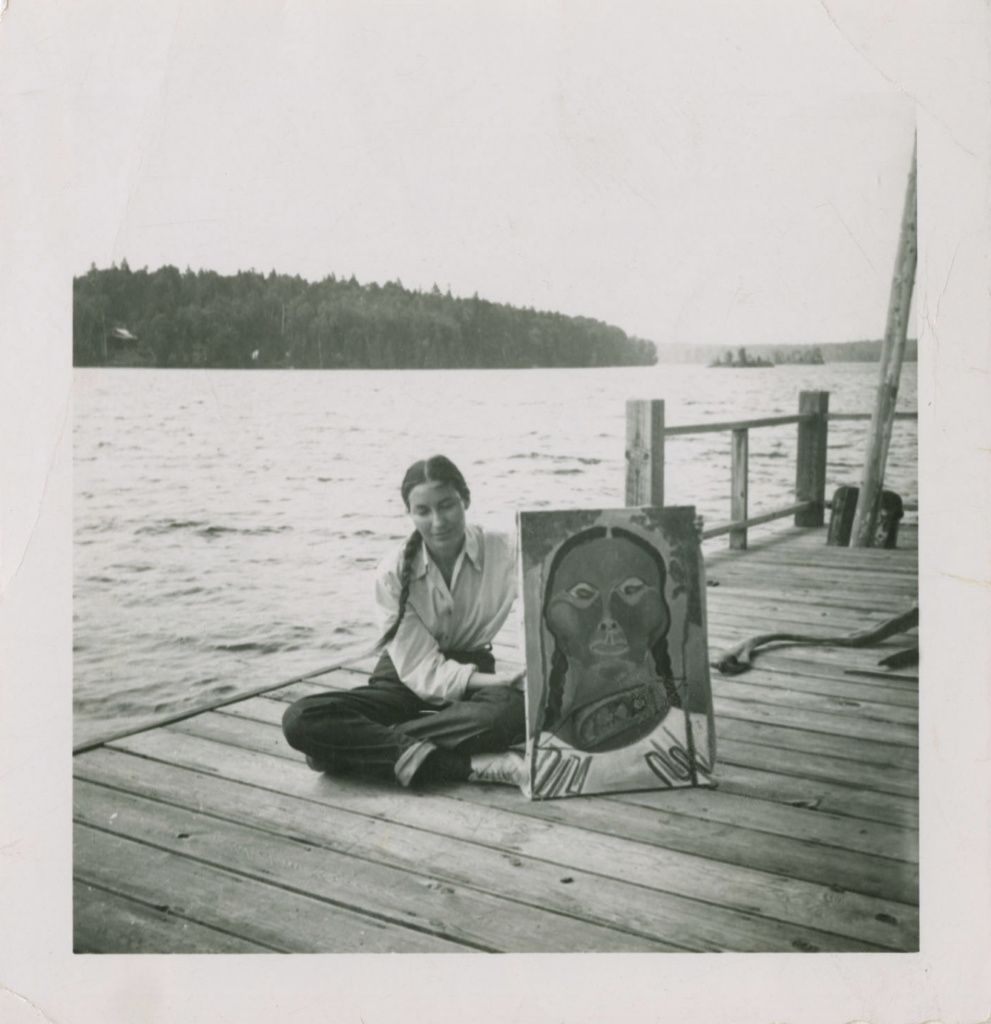
As we started digitizing her records, we discovered that this one box of papers is connected to many different parts of history, as discussed in previous blog posts and on the Rhoden portal. Richenda’s parents met at the Carlisle Indian School and her father was the first Native American judge in the state of Washington. Her first husband, Lawrence Lew Kay, who was tragically killed in WWII, has a rich family history rooted in China, and the Chinese community in Seattle, WA.
Richenda was not just defined by the men in her life. She was an incredible person in her own right. She has been described as head-strong, wanting to do things on her own terms, chic, and striking in beauty. John and Richenda never had children, but they dedicated their lives to the community. They always welcomed people into their house whether it was for an annual Christmas party or for the public to see their studio and art that was constantly on display.
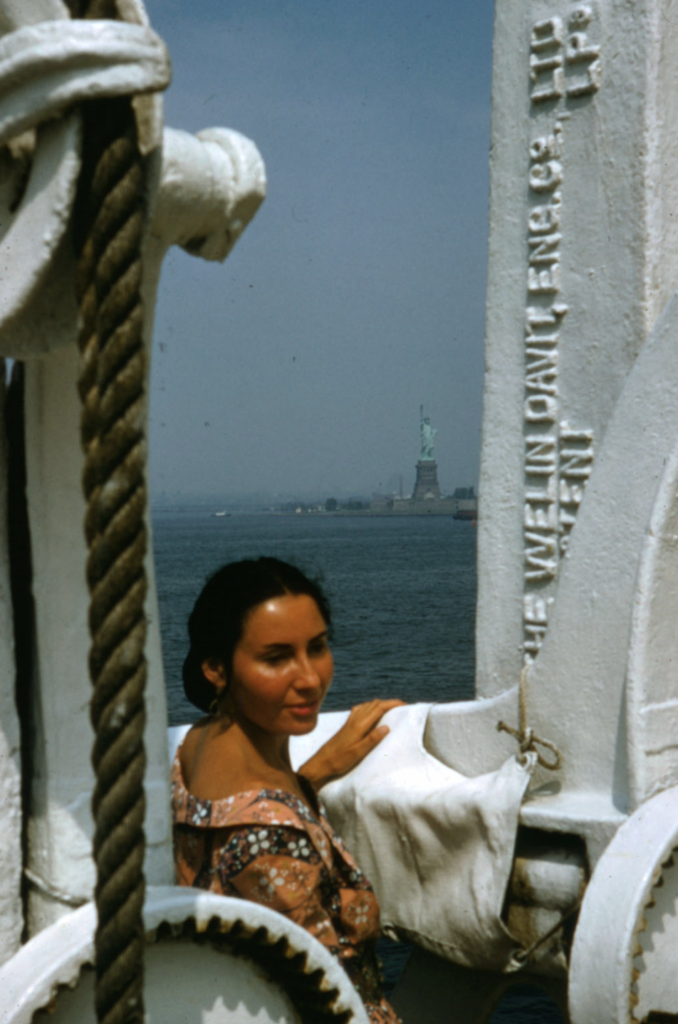
Richenda was an artist like her husband. She only showed a few times in her life, but she painted every day.
Richenda’s portion of the archive has made me question a lot about evidence in the archive. What is present, what is missing, and what does that mean? Richenda lived alone at 23 Cranberry Street for almost 15 years, and yet, we have very little of her own records. Despite all of this we have been able to find a rich history of a woman. Without a doubt, Richenda’s presence is evident and her history is recorded throughout the archive, whether it is in photographs, or labels she put on travel slides.
As Kelin and I wrap up this project, we are floored by the people on our team and members of the community that have helped us. From co-workers, family members translating Mandarin for us, to neighbors of the Rhodens sharing their stories. Lastly, huge thank you to Hoang Tran and Dr. Brittany Webb, who have been helping us and guiding us from day one.
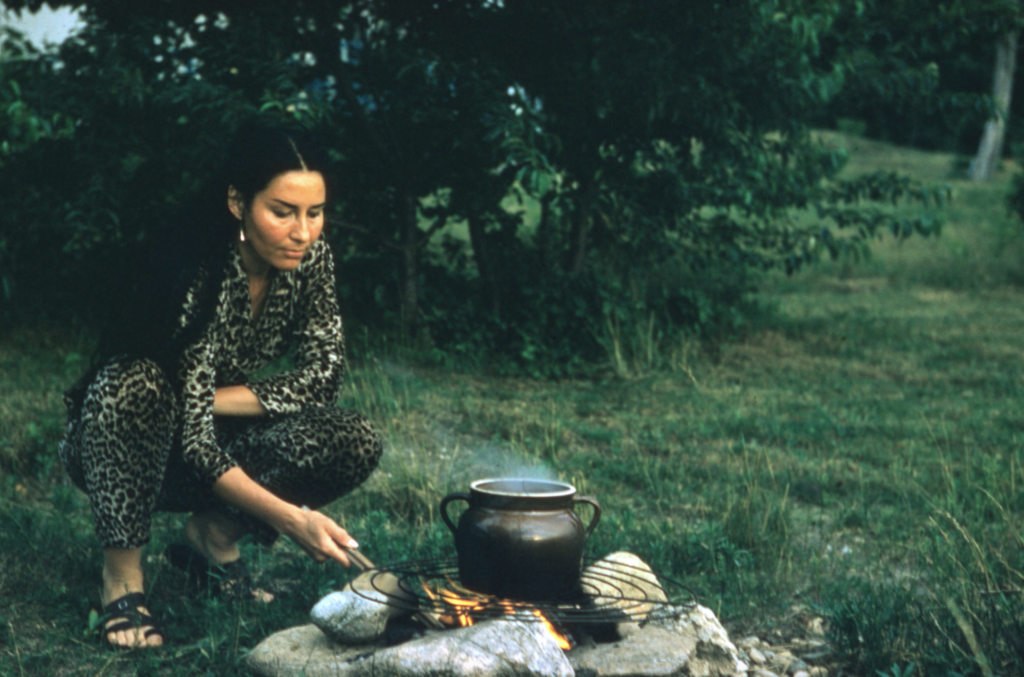
This project, Rediscovering John W. Rhoden: Processing, Cataloging, Rehousing, and Digitizing the John W. Rhoden papers, is funded in part by the National Endowment for the Humanities, a federal agency.
ABOUT THE NATIONAL ENDOWMENT FOR THE HUMANITIES
Created in 1965 as an independent federal agency, the National Endowment for the Humanities supports research and learning in history, literature, philosophy, and other areas of the humanities by funding selected, peer-reviewed proposals from around the nation. Additional information about the National Endowment for the Humanities and its grant programs is available at: www.neh.gov.
